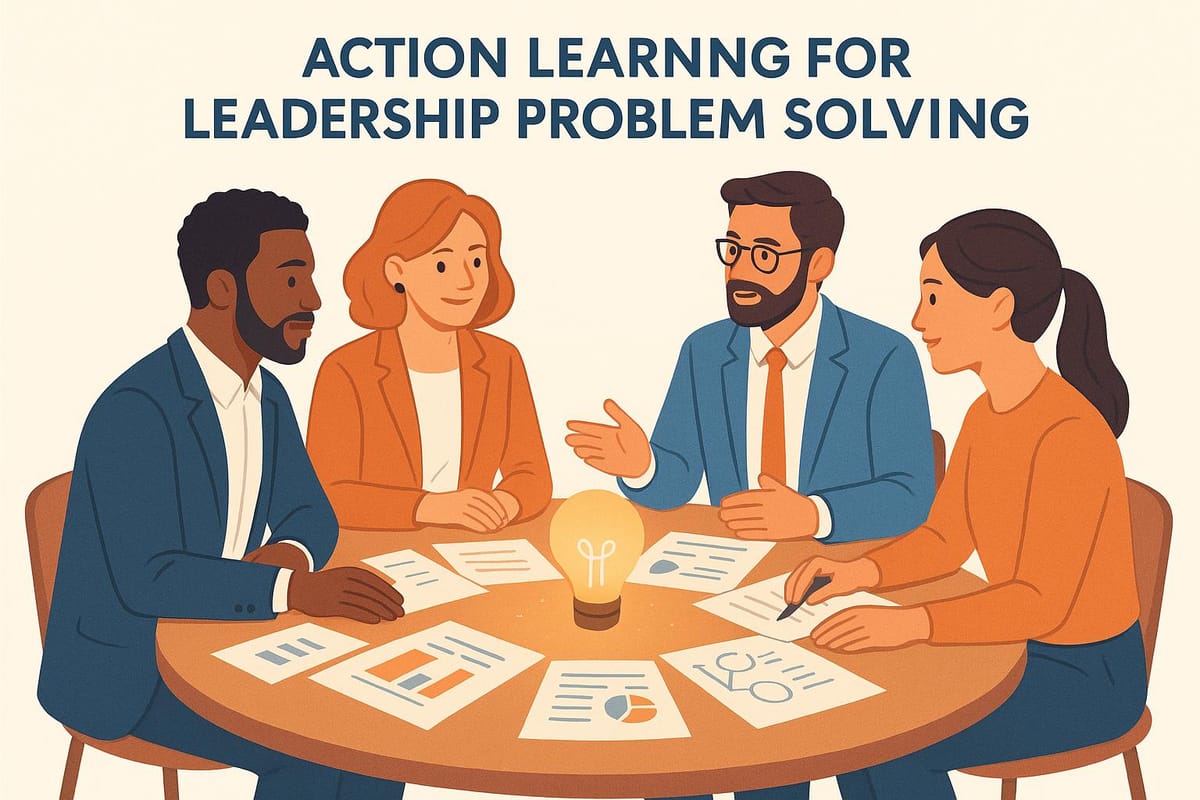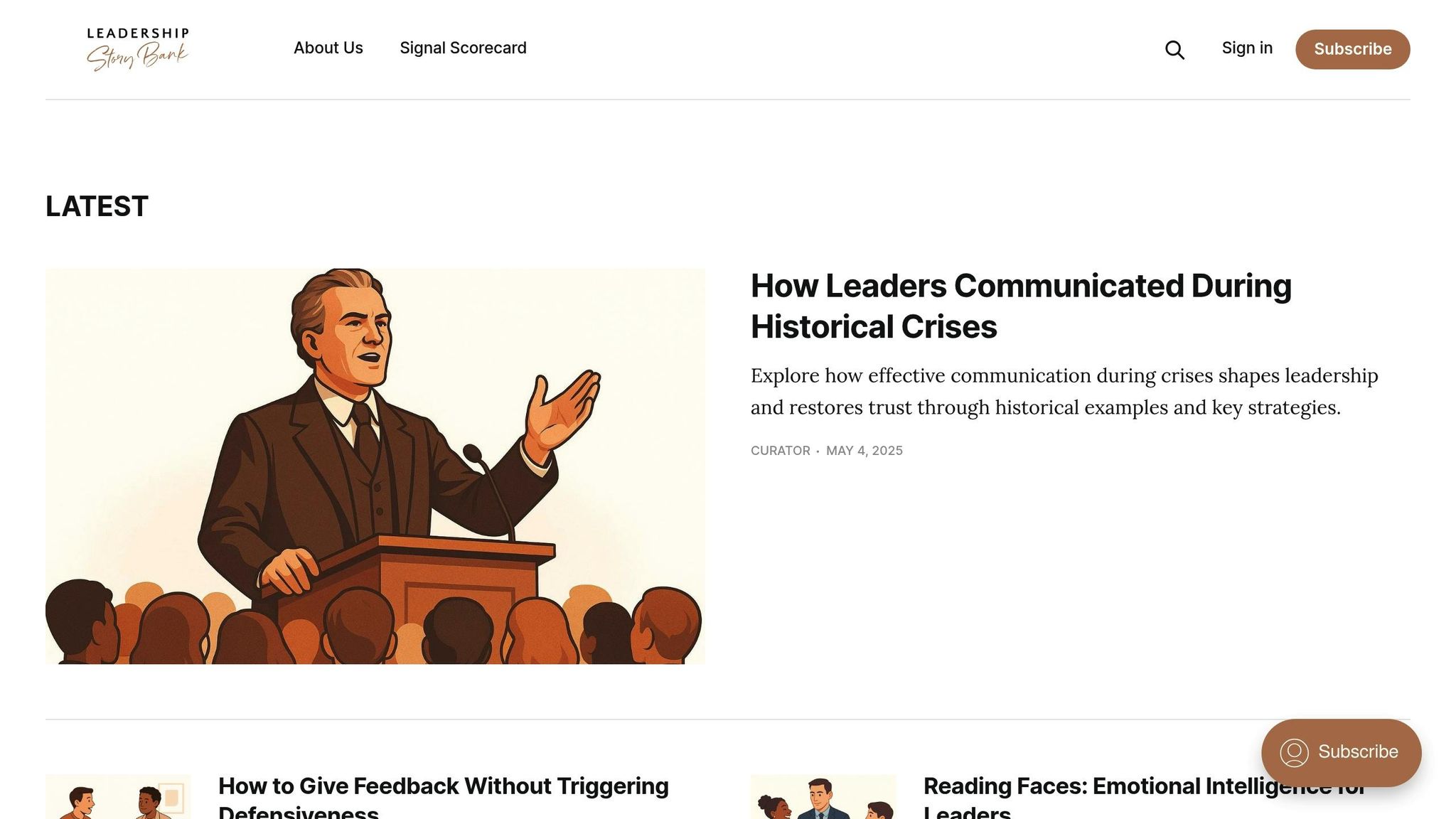Action Learning for Leadership Problem Solving
Action learning empowers leaders to solve real challenges through collaboration, reflection, and structured problem-solving techniques.

Action learning helps leaders solve real organisational problems while building critical skills. It’s a hands-on method where small teams collaborate, ask questions, and reflect to uncover solutions. This approach improves problem-solving, decision-making, and communication, while fostering teamwork and leadership growth.
Key Takeaways:
- Real Challenges: Focus on solving actual organisational issues rather than theoretical ones.
- Team Collaboration: Diverse teams of 4–8 members bring unique perspectives for creative solutions.
- Questioning and Reflection: Thoughtful questions and active listening uncover insights and drive progress.
- Structured Steps: Define the problem, build a balanced team, explore solutions, and implement actions.
By addressing real challenges and encouraging open dialogue, action learning develops leadership skills and improves organisational performance. Ready to apply it? Start with small teams, clear goals, and a skilled facilitator.
What is Action Learning and Why Does It Matter?
Main Elements of Action Learning
Action learning works by combining three key components that support leadership development and practical problem-solving.
Real Problems as Learning Opportunities
At the heart of action learning are actual organisational challenges. Rather than working with theoretical examples, participants tackle current issues impacting their organisation. This ensures the learning experience remains relevant and bridges the gap between theory and practice. By focusing on genuine problems, teams are better equipped to collaborate and find effective solutions.
Collaborative Problem Solving in Teams
Small, diverse teams are the backbone of action learning. These groups, typically made up of four to eight members from various departments or expertise areas, bring different viewpoints to the table. This variety in perspectives encourages critical thinking and leads to more creative solutions.
Each team includes specific roles that guide the process:
| Role | Responsibility | Contribution |
|---|---|---|
| Problem Presenter | Outlines the challenge | Gains new ideas and perspectives |
| Team Members | Ask probing questions and share insights | Develop leadership and problem-solving skills |
| Action Learning Coach | Oversees the process | Ensures learning goals are achieved |
| Observer (optional) | Offers feedback on team dynamics | Helps improve group collaboration |
This structure ensures discussions remain focused and productive, encouraging meaningful reflection and exploration.
The Power of Questions and Reflection
The questioning process is crucial in action learning. Participants are encouraged to ask thoughtful, challenging questions that push boundaries and reveal fresh insights. This reflective practice helps leaders:
- Understand complex problems by identifying hidden assumptions
- Strengthen team connections through open dialogue
- Turn abstract concepts into clear, actionable strategies
Steps in Action Learning
Setting the Problem
Start by clearly defining the leadership challenge at hand. The problem should be both important and achievable. Here's how to set it up:
- Pinpoint the main issue affecting leadership effectiveness.
- Collect relevant data to understand the context.
- Set clear, measurable goals.
- Think about the broader impact on the organisation.
Be specific when framing the challenge. For example, instead of saying, "We need better communication", try, "How can we improve cross-departmental collaboration to cut project delays by 25% in the next quarter?"
Building the Team
Once the problem is defined, put together a team with a mix of skills and perspectives. A balanced team ensures diverse input while staying efficient.
| Role | Key Qualities | Purpose |
|---|---|---|
| Subject Matter Experts | In-depth technical knowledge | Offer expert insights |
| Process Champions | Strong facilitation skills | Manage team interactions |
| Stakeholders | Direct involvement | Ensure solutions are practical |
| Fresh Perspectives | Unbiased viewpoints | Challenge existing assumptions |
Finding Solutions Through Questions
Tackle the problem by focusing on questions, moving through three distinct stages:
-
Initial Exploration
Begin with broad, open-ended questions to uncover the underlying issues rather than jumping to solutions. -
Deep Dive Analysis
Use targeted questions to challenge assumptions and dig into root causes. -
Solution Development
Collaboratively develop potential solutions through group inquiry.
This structured approach ensures a smooth transition from identifying the problem to planning actionable strategies.
Taking Action and Learning
Once solutions are refined, it's time to put them into practice and learn from the process. This phase includes:
- Crafting detailed implementation plans with milestones.
- Assigning clear responsibilities to team members.
- Setting up feedback systems to track progress.
- Recording lessons learned for future application.
Use measurable indicators to monitor success. For example, if the issue is leadership communication, track changes in team engagement scores or on-time project completion rates. Regular reflection sessions allow teams to evaluate progress, identify successes, and make adjustments as needed.
Results and Difficulties
Main Advantages
Action learning offers practical results for both leadership and organisational growth. It creates opportunities for immediate learning and actionable outcomes by focusing on:
- Team alignment: Setting clear goals and fostering effective communication ensures everyone is on the same page, driving better results.
- Creative problem-solving: Reflective discussions paired with strategic storytelling encourage new ways to address complex issues.
- Improved leadership communication: Using strategic storytelling helps leaders convey complex ideas in a relatable way, inspiring others to take action.
Common Problems and Solutions
Challenges in communication can slow progress. To address this, teams should establish clear communication protocols and adopt strategies tailored to their needs. This approach helps overcome common barriers and ensures smoother collaboration.
Side-by-Side Comparison
The table below highlights the strengths, challenges, and solutions in action learning:
| Aspect | Advantages | Primary Challenges | Solutions |
|---|---|---|---|
| Communication | Promotes team alignment through clear discussions | Miscommunication and misalignment | Use strong communication protocols and customised approaches |
Striking a balance between delivering measurable results and building leadership skills is crucial. By concentrating on clear objectives and effective communication, teams can achieve meaningful outcomes while continuously developing their leadership abilities.
Using Action Learning at Work
Getting Started
To introduce action learning at work, focus on tackling real leadership challenges. Start with a small, focused team of 4–6 members to keep discussions engaging and productive. Plan 90-minute sessions in a distraction-free environment, and establish clear ground rules that prioritise active listening and constructive questioning.
Assign a skilled facilitator to:
- Guide discussions fairly, ensuring no one dominates the conversation.
- Encourage equal participation so every member contributes meaningfully.
- Keep the group focused on learning goals and objectives.
- Document key takeaways and action points for follow-up.
Incorporating expert input and storytelling techniques can make the learning experience more impactful.
Leadership Story Bank Support

The Leadership Story Bank brings storytelling into action learning, using it to clarify challenges and inspire collaboration.
"Effective storytelling transforms leadership communication, making complex ideas relatable and inspiring action through emotional connections." - Leadership Story Bank
This platform helps leaders craft stories that:
- Explain organisational challenges more clearly.
- Build trust among team members.
- Boost engagement during problem-solving discussions.
- Turn abstract ideas into practical, actionable insights.
UK Implementation Guide
For workplaces in the UK, action learning can be tailored with a focus on strategic planning and storytelling. Here's a guide to get started:
| Phase | Focus Areas | Key Activities |
|---|---|---|
| Planning | Team Structure | Select 4–6 participants from various departments. |
| Implementation | Session Format | Schedule 90-minute sessions every two weeks. |
| Evaluation | Progress Tracking | Record results and key lessons learned. |
In British organisations, incorporating tea breaks into longer sessions can help foster stronger connections and encourage open dialogue. Schedule sessions during standard working hours, typically 9:00 to 17:30, to ensure accessibility.
Create a safe environment where participants feel comfortable discussing challenges. Since British workplace culture often values subtle communication and diplomatic feedback, facilitators should respect these norms while encouraging honest and constructive conversations.
When addressing challenges, consider UK-specific factors like:
- Remote work setups across different regions.
- Effective communication within diverse, multicultural teams.
- Industry-specific regulatory requirements.
- Adjustments related to Brexit and its impact on business operations.
To succeed, ensure ongoing support from senior leadership and regularly evaluate progress. Use measurable outcomes such as improved teamwork, faster problem-solving, and enhanced leadership skills to track success.
Conclusion
Action learning provides a structured way to develop leadership skills while tackling real-world challenges. By focusing on team-based problem solving and reflective questioning, leaders can address critical issues and improve their abilities simultaneously.
This hands-on approach not only resolves immediate concerns but also builds long-term skills. Its focus on teamwork and effective communication allows organisations to make meaningful progress and drive positive change.
In the UK, action learning promotes practical solutions, shared insights, and regular reflection. These key aspects highlight the framework's value, reinforcing earlier points in our discussion.
To maintain these benefits, organisations need to prioritise open communication, clear alignment with goals, and consistent effort. Encouraging active listening, thoughtful questioning, constructive feedback, and effective storytelling can help maximise the impact of action learning.
FAQs
How can organisations effectively use action learning to tackle leadership challenges in remote teams?
Action learning can be a powerful tool for addressing leadership challenges in remote teams by fostering collaboration, critical thinking, and real-time problem-solving. To implement it effectively in a remote setting:
- Leverage technology: Use video conferencing and collaboration platforms to create a virtual space for action learning sessions. Ensure all participants are comfortable with the tools being used.
- Set clear goals: Define the leadership challenge to be addressed and establish specific objectives for the group to work towards.
- Encourage inclusivity: Involve team members from diverse backgrounds and roles to bring varied perspectives to the discussion.
By focusing on open communication and structured reflection, action learning can help remote teams build stronger leadership skills and solve complex problems collaboratively.
How does storytelling enhance the action learning process in leadership development?
Storytelling plays a crucial role in enriching the action learning process for leadership development. By sharing personal or team experiences, leaders can contextualise challenges, foster deeper understanding, and encourage collaborative problem-solving. Stories help to humanise complex issues, making them more relatable and easier to address.
Additionally, storytelling allows leaders to reflect on their own journeys, uncover valuable lessons, and communicate with greater clarity and impact. This not only strengthens their self-awareness but also inspires and engages their teams, creating a more dynamic and effective learning environment.
How is action learning different from traditional problem-solving methods, and what are its benefits for leadership development?
Action learning stands out from traditional problem-solving methods by focusing on tackling real-world challenges in real time while fostering personal and group development. It combines practical problem-solving with reflection and collaboration, enabling participants to learn by doing and grow as leaders in the process.
Unlike conventional approaches, which often emphasise theoretical analysis, action learning encourages leaders to work within a supportive group to explore solutions, refine their thinking, and build critical leadership skills such as communication, adaptability, and decision-making. This hands-on, reflective approach ensures that both the problem and the leader grow stronger through the process.
